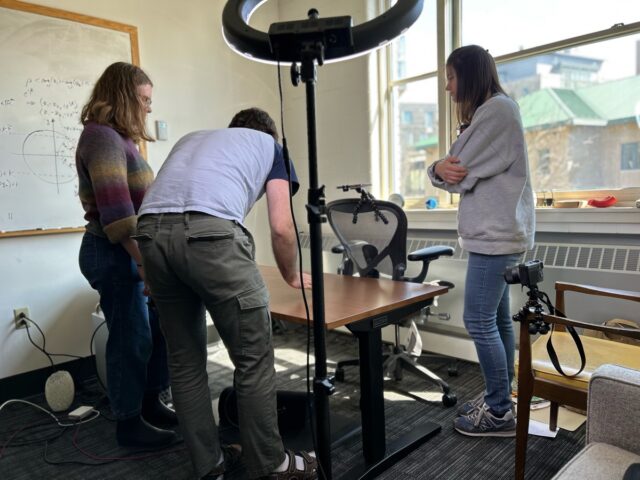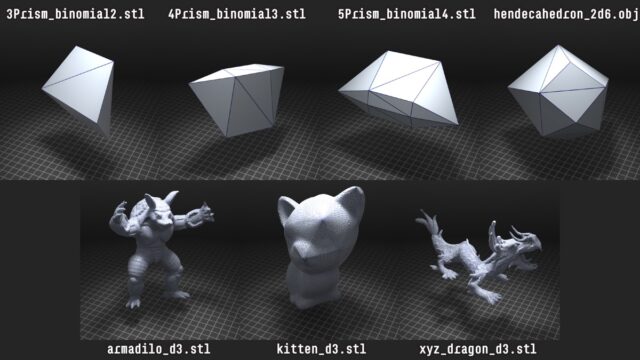"Let it roll, baby, roll"
Statistically, "the real behavior of a rolling object is largely a function of its geometry."
What if you could make your dice any shape at all—not just boxes and polyhedra, but dragons or other game-relevant shapes?
Most people are familiar with conventional cubical six-sided dice, but there are also polyhedral versions like the 20-sided dice used in ancient Rome and to play Dungeons and Dragons. Researchers have figured out how to design dice with even more exotic shapes, like a kitten, a dragon, or an armadillo. And they are "fair" dice: Experiments with 3D-printed versions produced results that closely matched predicted random outcomes, according to a forthcoming paper currently in press at the journal ACM Transactions on Graphics.
Dice are examples of so-called "rigid bodies," broadly defined as shapes that move as one solid piece, with no need for bending or twisting. Such shapes "are of scientific interest because they model so many of the phenomena we encounter in our daily lives: anything from the way your dishes roll around on the floor when you drop them, to how the gears in your watch push on each other, to how a satellite tumbles around under the pull of gravity," co-author Keenan Crane of Carnegie-Mellon University told Ars. "So there's an intense focus on developing computational methods for understanding and predicting how rigid bodies are going to behave."
Crane and his co-authors—including lead author and CMU graduate student Hossein Baktash, as well as co-authors from Nvidia Research and Adobe Research—wanted to explore where and how a rigid body will land when tossed. They chose dice as the best (and most fun) context in which to explore that question.
"But it's also helpful to understand, for instance, if you load up a 3D model on your computer, how should it be displayed on screen—which direction is 'up'?" said Crane. "Or if you drop a rigid object in the ocean, can you design it so that it lands with the proper orientation, with high probability?"

Conducting trial throws of each of seven unusually shaped dice. Credit: Keenan Crane
The group began with the assumption that when it comes to the rest behavior of a rolling irregularly shaped rigid body—such as the pig-shaped "dice" from the commercial game Pass the Pigs—the effects of momentum would be negligible. They wanted to approach the problem from the perspective of analytical geometry rather than dynamical simulations, so they essentially mapped the corners, edges, and faces onto a sphere and simulated how gravity would act upon such objects as they fell and came to rest.
The ultimate objective was to estimate the probability distribution over the possible range of resting configurations using just geometry. They ran multiple computer simulations of seven weirdly shaped designs for dice and then created physical 3D-printed versions to test them experimentally, tossing each die between 100 and 1,000 times.
They tweaked each shape until the experimental resting positions were within 3 or 4 percent of the predicted probability outcomes. These designs included a single die simulating two rolling six-sided dice (D6+D6); two binomial dice simulating flipping two and three fair coins, respectively; and three versions of a single die with three equally likely outcomes, shaped like a kitten, an armadillo, and a dragon. They also analyzed a talus-shaped model, similar to the sheep's knuckles or "astragali" used as dice in antiquity for gambling or divination. Baktash recalled playing with such objects as a child growing up in Iran.
"These irregular dice were in a way similar to the ones we’ve designed, in that they don’t have even probabilities—like 1/4, 1/4, 1/4, 1/4—but rather depend on the very particular shape of the knuckles," said Crane. "People bet on different outcomes, using past experience to build up their intuition about which sides are most likely. Hossein’s tool can do this much more directly: By just looking at the shape, it can directly give you some pretty accurate probabilities. If we were able to time travel back and gamble in ancient Greece, we might be able to make a lot of money (in BC-adjusted dollar)."
The algorithm efficiently and robustly computed the probability of all resting configurations (in 3 ms) of the pig model from the popular game Pass the Pigs. Keenan Crane
So one day soon, gamers might be able to choose from a wide selection of exotically shaped dice for future play—and even 3D print their own designs. (You can already 3D print the team's designs since Baktash posted the STL files.) The new tool might also prove useful for creating natural-looking arrangements of geometry or adjusting a design so that an object is better able to stand upright, akin to the "Daruma doll," a traditional Japanese toy that is hollow and weighted at the bottom so that it always returns to an upright position when tilted over. "Our approach makes it possible to bake this property into the geometry of the shape itself," said Crane.
As for more "serious" applications, Crane points to underwater construction, "where the low-momentum assumption is very realistic and it's important for things to land in the proper orientation," he said. "Alternatively, if you imagine each little grain of sand or soil is a rigid particle, the statistics of how they land might help understand things like how soil settles and compacts. The exciting thing about putting research like this out in the world is that, a few years later, other folks inevitably find use cases for it that we never could have imagined."
There are some inevitable tradeoffs. Oklahoma State University mathematician Henry Segerman told New Scientist that the method isn't "necessarily a silver-bullet solution to designing weird dice, because it ignores friction, bouncing, and other real-world momentum effects. It’s more like they are—very efficiently—predicting where a die ends up if you put it down with a random orientation on a non-slip surface in low gravity. It slowly falls over and rolls down to land, without slipping or bouncing."
Crane and his co-authors acknowledge as much in their paper. "On the one hand, [critics] are absolutely correct that our model does not make perfect predictions from the perspective of idealized geometry and physics," said Crane. "On the other hand, if your goal is to literally make dice for tabletop games, it's perfectly reasonable to make these kinds of approximations."

You can 3D print these unusually shaped dice using the STL files. Credit: Hossein Baktash
That's partly because of the nature of statistics. "If you flip a coin or roll a die only a few times, it can be very hard to tell whether it's fair or not," said Crane. "Suppose I roll a 6-sided die just once, and it comes up with a '5.' Is it fair, or not? Impossible to say. Likewise, if I play Settlers of Catan, I might roll the dice only about 100 times in the whole game. Even if the dice are actually fair, the distribution of rolls I see throughout this short game might vary quite a bit from the idealized distribution—I might just happen to roll a lot more nines that game than usual. So, in a real game, there may not be a huge practical difference between using fair dice and dice that have a small bias. The signal-to-noise ratio is so low that the practical effect over a short game is pretty small."
Then there is the human factor: Even assuming perfect dice, how people handle them is imperfect and unpredictable; even fair coins don't yield 50/50 odds because of that. "There will always be some kind of 'dice handling bias' due to the way that people pick up, shake (or not shake!), and toss dice," said Crane. "If you wanted to make dice that exhibit perfect statistics in practice, rather than just in theory, you might need to take an interdisciplinary approach that incorporated not just geometry and physics, but also ideas from psychology, design, and so on."
"I think the reality is that if we wanted more perfect statistics, we would just ask a computer to generate a random number," Crane concluded. "The reason people use dice for tabletop games is because it's tactile and fun. I think Hossein's approach does a great job of making dice rolling even more fun—while still remaining grounded on some solid mathematical principles."
Jennifer is a senior writer at Ars Technica with a particular focus on where science meets culture, covering everything from physics and related interdisciplinary topics to her favorite films and TV series. Jennifer lives in Baltimore with her spouse, physicist Sean M. Carroll, and their two cats, Ariel and Caliban.











 English (US) ·
English (US) ·